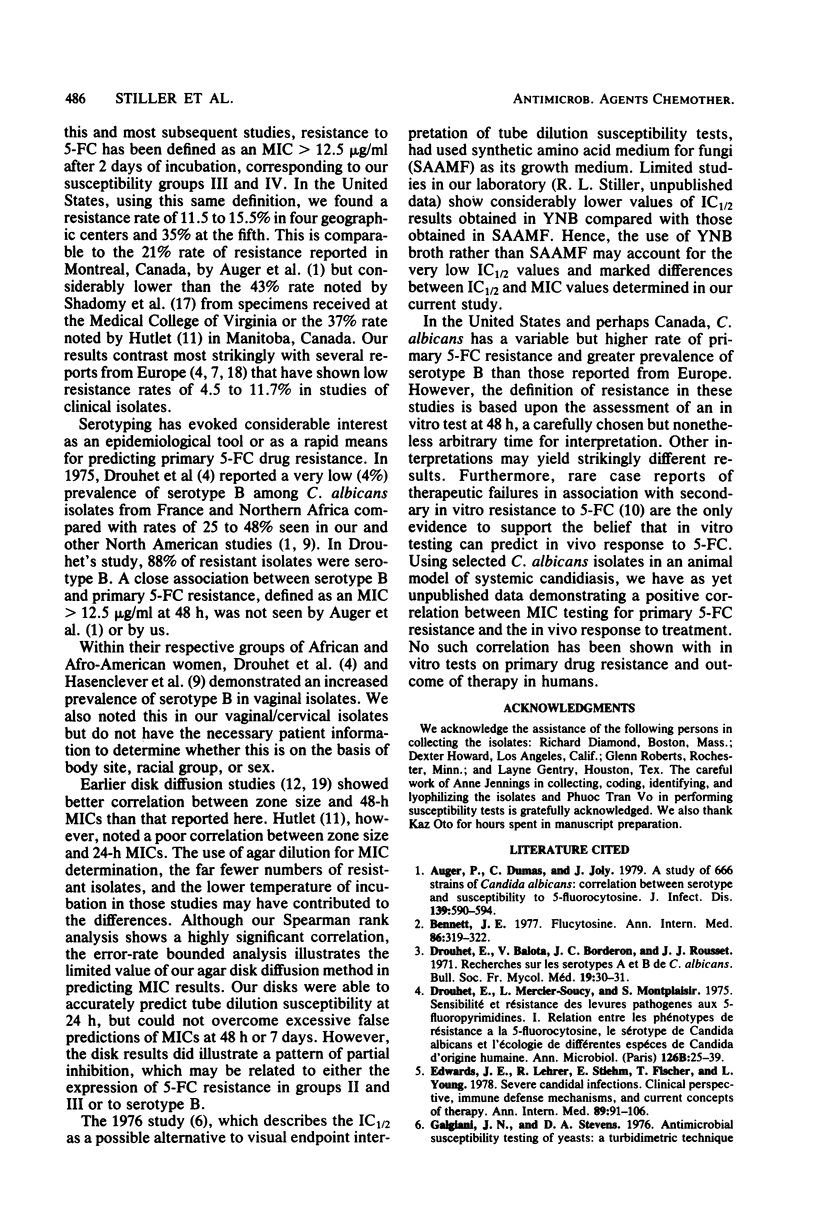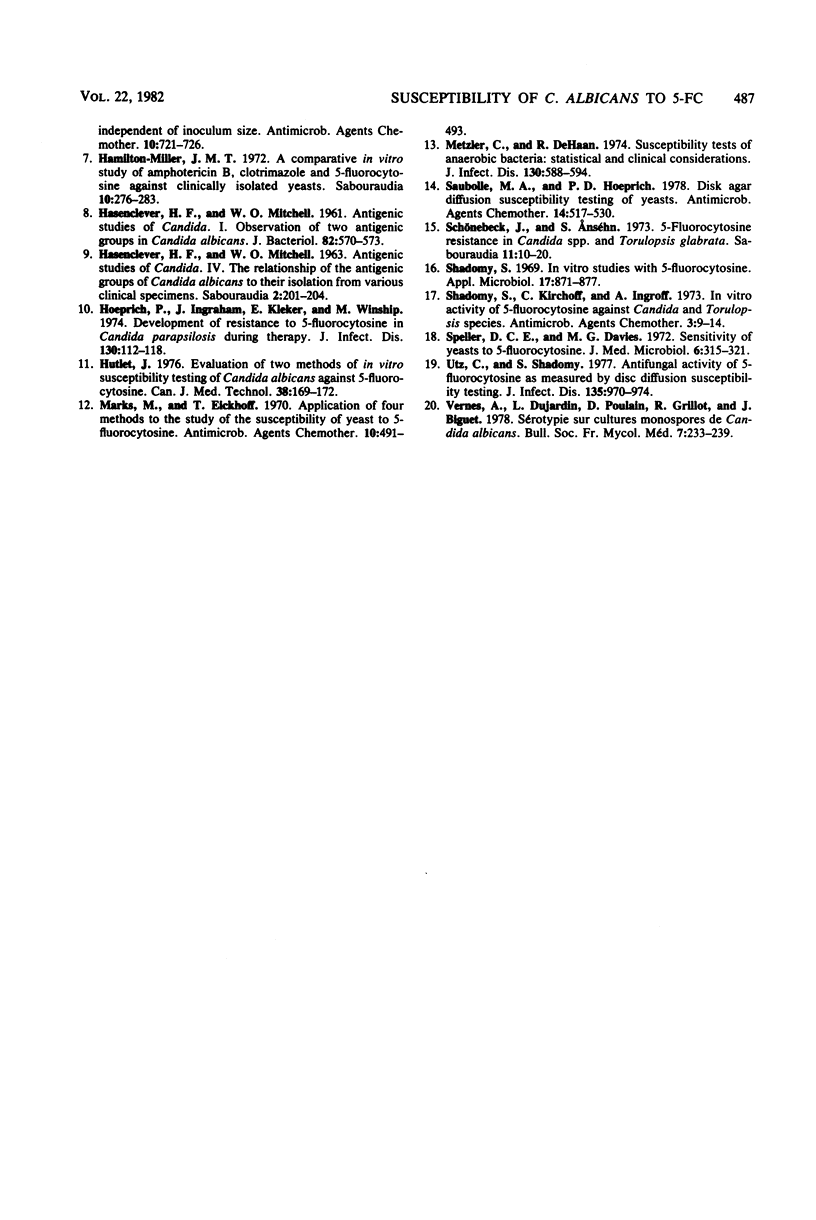Abstract
Candida albicans isolates from 402 patients with no prior history of treatment with 5-fluorocytosine were collected at five medical centers from different areas of the United States. Isolates could be separated into four groups based on their minimum inhibitory concentrations (MICs) to 5-fluorocytosine. Group I isolates (60%) had MICs less than or equal to 12.5 micrograms/ml after 7 days, whereas groups II (22%), III (14%), and IV (4%) demonstrated MICs greater than 12.5 micrograms/ml on days 7, 2, and 1, respectively. Serotypes A and B accounted for 50.7 and 49.3%, respectively, of the 398 isolates typed. Serotype B was less prevalent in group I (26%), but predominated in the more resistant groups, groups II (85%), III (86%), and IV (53%). The common practice of identifying as "resistant" those isolates with MICs greater than 12.5 micrograms/ml after 48 h of incubation would yield a resistance rate in the United States of 11.5 to 15.5% in four centers and 35% in the fifth. Although serotype B and small agar disk diffusion zone sizes correlated with poor 5-fluorocytosine susceptibility, their ability to predict tube dilution MICs was limited. The true predictive value of such tests awaits correlation with in vivo studies.
Full text
PDF





Images in this article
Selected References
These references are in PubMed. This may not be the complete list of references from this article.
- Auger P., Dumas C., Joly J. A study of 666 strains of Candida albicans: correlation between serotype and susceptibility to 5-fluorocytosine. J Infect Dis. 1979 May;139(5):590–594. doi: 10.1093/infdis/139.5.590. [DOI] [PubMed] [Google Scholar]
- Bennet J. E. Flucytosine. Ann Intern Med. 1977 Mar;86(3):319–321. doi: 10.7326/0003-4819-86-3-319. [DOI] [PubMed] [Google Scholar]
- Drouhet E., Mercier-Soucy L., Montplaisir S. Sensibilité et résistance des levures pathogènes aux 5-fluoropyrimidines. I.--Relation entre les phénotypes de résistance a la 5-fluorocytosine, le sérotype de Candida albicans et l'écologie de différentes espèces de Candida d'origine humaine. Ann Microbiol (Paris) 1975 Jul-Aug;126B(1):25–39. [PubMed] [Google Scholar]
- Edwards J. E., Jr, Lehrer R. I., Stiehm E. R., Fischer T. J., Young L. S. Severe candidal infections: clinical perspective, immune defense mechanisms, and current concepts of therapy. Ann Intern Med. 1978 Jul;89(1):91–106. doi: 10.7326/0003-4819-89-1-91. [DOI] [PubMed] [Google Scholar]
- Galgiani J. N., Stevens D. A. Antimicrobial susceptibility testing of yeasts: a turbidimetric technique independent of inoculum size. Antimicrob Agents Chemother. 1976 Oct;10(4):721–728. doi: 10.1128/aac.10.4.721. [DOI] [PMC free article] [PubMed] [Google Scholar]
- HASENCLEVER H. F., MITCHELL W. O. Antigenic studies of Candida. I. Observation of two antigenic groups in Candida albicans. J Bacteriol. 1961 Oct;82:570–573. doi: 10.1128/jb.82.4.570-573.1961. [DOI] [PMC free article] [PubMed] [Google Scholar]
- Hamilton-Miller J. M. A comparative in vitro study of amphotericin B 1 clotrimazole and 5-fluorocytosine against clinically isolated yeasts. Sabouraudia. 1972 Nov;10(3):276–283. [PubMed] [Google Scholar]
- Hoeprich P. D., Ingraham J. L., Kleker E., Winship M. J. Development of resistance to 5-fluorocytosine in Candida parapsilosis during therapy. J Infect Dis. 1974 Aug;130(2):112–118. doi: 10.1093/infdis/130.2.112. [DOI] [PubMed] [Google Scholar]
- Marks M. I., Eickhoff T. C. Application of four methods to the study of the susceptibility of yeast to 5-fluorocytosine. Antimicrob Agents Chemother (Bethesda) 1970;10:491–493. [PubMed] [Google Scholar]
- Metzler C. M., DeHaan R. M. Susceptibility tests of anaerobic bacteria: statistical and clinical considerations. J Infect Dis. 1974 Dec;130(6):588–594. doi: 10.1093/infdis/130.6.588. [DOI] [PubMed] [Google Scholar]
- Saubolle M. A., Hoeprich P. D. Disk agar diffusion susceptibility testing of yeasts. Antimicrob Agents Chemother. 1978 Oct;14(4):517–530. doi: 10.1128/aac.14.4.517. [DOI] [PMC free article] [PubMed] [Google Scholar]
- Schönebeck J., Anséhn S. 5-Fluorocytosine resistance in candida spp. and Torulopsis glabrata. Sabouraudia. 1973 Mar;11(1):10–20. doi: 10.1080/00362177385190041. [DOI] [PubMed] [Google Scholar]
- Shadomy S. In vitro studies with 5-fluorocytosine. Appl Microbiol. 1969 Jun;17(6):871–877. doi: 10.1128/am.17.6.871-877.1969. [DOI] [PMC free article] [PubMed] [Google Scholar]
- Shadomy S., Kirchoff C. B., Ingroff A. E. In vitro activity of 5-fluorocytosine against Candida and Torulopsis species. Antimicrob Agents Chemother. 1973 Jan;3(1):9–14. doi: 10.1128/aac.3.1.9. [DOI] [PMC free article] [PubMed] [Google Scholar]
- Speller D. C., Davies M. G. Sensitivity of yeasts to 5-fluorocytosine. J Med Microbiol. 1973 Aug;6(3):315–321. doi: 10.1099/00222615-6-3-315. [DOI] [PubMed] [Google Scholar]
- Utz C. J., Shadomy S. Antifungal activity of 5-fluorocytosine as measured by disk diffusion susceptibility testing. J Infect Dis. 1977 Jun;135(6):970–974. doi: 10.1093/infdis/135.6.970. [DOI] [PubMed] [Google Scholar]





